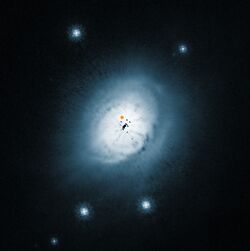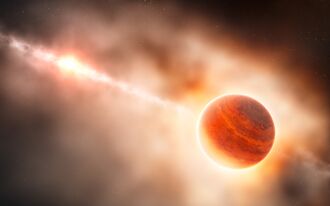إتش دي 100546
 This image from the NASA/ESA Hubble Space Telescope shows a visible light view of the outer dust around the young star HD 100546, with the newly discovered protoplanet positioned and marked by an orange spot. Artifacts from the brilliant central star dominate the inner part of this picture, which has been digitally subtracted. Black blobs are also artifacts.[1][2] | |
| بيانات الرصـد الحقبة J2000.0[3] اعتدال J2000.0[3] | |
|---|---|
| الكوكبة | Musca |
| الصعود المستقيم | 11س 33د 25.441ث[4] |
| الميل | −70° 11′ 41.24″[4] |
| القدر الظاهري (V) | 6.698[3] |
| الخـصـائص | |
| النوع الطيفي | B9Vne[3] |
| التـفـاصـيل | |
| العمر | >10[5] م.س. |
| علم القياسات الفلكية | |
| الحركة الحقيقية (μ) | RA: −38.93 ± 0.36[4] mas/yr Dec.: 0.29 ± 0.38[4] mas/س |
| اختلاف المنظر (π) | 10.32 ± 0.43[4] mas |
| المسافة | س ض ( ف ن) |
| تسميات أخرى | |
| مراجع قواعد البيانات | |
| SIMBAD | data |
إتش دي 100546، هو نجم على بعد 337.3 سنة ضوئية من الأرض. يدور حوله حوالي 20 Mj كوكب على بعد 6.5 وحدة فلكية، [6] although further examination of the disk profile indicate it might be a more massive object such as a brown dwarf or more than one planet.[7] The star is surrounded by a circumstellar disk from a distance of 0.2 to 4 AU, and again from 13 AU out to a few hundred AU, with evidence for a protoplanet forming at a distance of around 47 AU.[8]
Estimated to be around 10 million years old, it is at the upper age limit of the class of stars it belongs to—Herbig Ae/Be stars, and also the nearest example to the Solar System.[5]
 Artist's impression of HD 100546 b | |
| السمات المدارية | |
|---|---|
| 6.5 AU (970،000،000 km) | |
| السمات الطبيعية | |
نصف القطر المتوسط | 6.9+2.7 −2.9[9] (Surrounding disk)[8][أ] RJ |
Mean radius | 6.9+2.7 −2.9[9] (Surrounding disk)[8][أ] RJ |
| Mass | 3.1 MJ[10] |
| Temperature | 932+193 −202[9] K |
| السمات المدارية | |
|---|---|
| 110 AU | |
| السمات الطبيعية | |
| Mass | 8.5 MJ |
نظام كوكبي
| المرافق (بالترتيب من النجم) |
الكتلة | نصف المحور الرئيسي (و.ف.) |
الدور المداري (يوم) |
الانحراف | الميل | نصف القطر |
|---|---|---|---|---|---|---|
| b (disputed[11]) | 3.1[10] MJ | 15[10] | 90958 | — | — | < 6.9 RJ |
| c (unconfirmed) | 8.5[10] MJ | 110[10] | — | — | — | — |
احتمال تكوين كوكب جديد
في 2013، أعلن باحثون عن عثورهم على أدلة لعملية تكوين كوكب جديد، وذلك باستخدام the UVES echelle spectrograph at the VLT in Chile.[6] This confirms other data indicating a planetary companion. HD 100546 b might be the largest exoplanet discovered with a size of the planet and surrounding disk[8] of around 6.9 RJ; the planet's size puts it near the border between a large planet and a brown dwarf.[9][6]
However, the position where HD 100546 b was detected was inside compared with the gap between the inner and outer disks, and outside compared with the central cavity, so the validity of the planet was shown from the characteristics of the star disk. There was a discrepancy with the discussion. As a result of further detailed observation of the position where HD 100546 b was detected, the light source identified as HD 100546 b appeared to be a point light source in the analysis under specific conditions, but in many cases it became a more diffuse structure. Visible part may be not the planet itself, but the disturbance in disk caused by the much smaller (~10M⊕) planet completely embedded in the dust shroud.[11]
قرص حول نجم
Coronagraphic optical observations with the Hubble Space Telescope[1][5] show complex spiral patterns in the circumstellar disk. The causes of these structures remain uncertain, although spirals are consistent with the instabilities caused by forming planets.[10] The disk colors are similar to those derived for Kuiper Belt objects, suggesting that the same weathering processes are at work in HD 100546. The disk is fairly flat, consistent with an advanced evolutionary state,[1] and have a wide gap at 40–150 AU radii, possibly carved by the outer planet in the gap.[10]
Spectroscopic analysis of mid-IR data taken from OSCIR on the 4 m Blanco Telescope at Cerro Tololo Inter-American Observatory indicates the presence of a small particles (10–18 μm) containing silicates.[5] The material is found at distances out to 17 AU away from the star and has a temperature of approximately 227 K.[5]
انظر أيضاً
- List of star extremes
- List of exoplanet extremes
- Jupiter, the largest planet in the solar system
المصادر
- ^ أ ب ت Ardila, D. R.; Golimowski, D. A.; Krist, J. E.; Clmapin, M.; Ford, H. C.; Illingworth, G. D. (2007). "Hubble Space Telescope Advanced Camera for Surveys Coronagraphic Observations of the Dust Surrounding HD 100546". Astrophysical Journal. 665 (1): 512–534. arXiv:0704.1507. Bibcode:2007ApJ...665..512A. doi:10.1086/519296.
- ^ "The Birth of a Giant Planet?". ESO. Retrieved 3 April 2013.
- ^ أ ب ت ث "HD 100546". SIMBAD. Centre de données astronomiques de Strasbourg. Retrieved 8 March 2018.
- ^ أ ب ت ث ج van Leeuwen, F. (2007). "Validation of the new Hipparcos reduction". Astronomy and Astrophysics. 474 (2): 653–664. arXiv:0708.1752. Bibcode:2007A&A...474..653V. doi:10.1051/0004-6361:20078357. S2CID 18759600.Vizier catalog entry
- ^ أ ب ت ث ج Grady, C. A.; et al. (2001). "The Disk and Environment of the Herbig Be Star HD 100546". The Astronomical Journal. 122 (6): 3396–3406. Bibcode:2001AJ....122.3396G. doi:10.1086/324447.
- ^ أ ب ت Acke, B.; van der Ancker, M. (November 2005). "Resolving the disk rotation of HD 97048 and HD 100546 in the [O I] 6300A line: evidence for a giant planet orbiting HD 100546". Astronomy and Astrophysics. 449 (267): 267. arXiv:astro-ph/0512562. Bibcode:2006A&A...449..267A. doi:10.1051/0004-6361:20054330. S2CID 10148216.
- ^ Mulders, Gijs D.; Paardekooper, Sijme-Jan; Pani´c, Olja; Dominik, Carsten; et al. (2013). "Planet or Brown Dwarf? Inferring the Companion Mass in HD 100546 from the Wall Shape using Mid-Infrared Interferometry". Astronomy & Astrophysics. 557A (A68): 10. arXiv:1306.4264. Bibcode:2013A&A...557A..68M. doi:10.1051/0004-6361/201220930. S2CID 9014058.
- ^ أ ب ت Quanz, Sasch P.; Amara, Adam; Meyer, Michael P.; Kenworthy, Matthew P.; et al. (2013). "A young protoplanet candidate embedded in the circumstellar disk of HD 100546". Astrophysical Journal. 766 (1). L1. arXiv:1302.7122. Bibcode:2013ApJ...766L...1Q. doi:10.1088/2041-8205/766/1/l1. S2CID 56140977.
- ^ أ ب ت Quanz, Sasch P.; Amara, Adam; Meyer, Michael P.; Kenworthy, Matthew P.; et al. (2014). "Confirmation and characterization of the protoplanet HD100546 b - Direct evidence for gas giant planet formation at 50 au". Astrophysical Journal. 807 (1). 64. arXiv:1412.5173. Bibcode:2015ApJ...807...64Q. doi:10.1088/0004-637X/807/1/64. S2CID 119119314.
- ^ أ ب ت ث ج ح خ Fedele, D.; Toci, C.; Maud, L.; Lodato, G. (2021), ALMA 870 μm continuum observations of HD 100546. Evidence of a giant planet on a wide orbit
- ^ أ ب The Doppler-flip in HD 100546 as a disk eruption: the elephant in the room of kinematic protoplanet searches, 2022
ملاحظات
- ^ The size of planet cannot be determined in size as flux from planet and disk are superimposed.
للاستزادة
- Butler, R. P.; et al. (2006). "Catalog of Nearby Exoplanets". The Astrophysical Journal. 646 (1): 505–522. arXiv:astro-ph/0607493. Bibcode:2006ApJ...646..505B. doi:10.1086/504701. S2CID 119067572.
- Ecuvillon, A.; Israelian, G.; Pont, F.; Santos, N.; et al. (August 2006). "Kinematics of planet-host stars and their relation to dynamical streams in the solar neighbourhood". Astronomy and Astrophysics. 461 (171): 171–182. arXiv:astro-ph/0608669. Bibcode:2007A&A...461..171E. doi:10.1051/0004-6361:20065872. S2CID 16935788.
- Jones, B.; Sleep, P.; Underwood, D. (June 2006). "Habitability of known exoplanetary systems based on measured stellar properties". The Astrophysical Journal. 649 (1010): 1010–1019. arXiv:astro-ph/0603200. Bibcode:2006ApJ...649.1010J. doi:10.1086/506557. S2CID 119078585.
- Mandell, Avi M.; Raymond, Sean N.; Sigurdsson, Steinn (May 2007). "Formation of Earth-like Planets During and After Giant Planet Migration". The Astrophysical Journal. 660 (1): 823–844. arXiv:astro-ph/0701048. Bibcode:2007ApJ...660..823M. doi:10.1086/512759. S2CID 4812445.
- Marchi, S. (May 2007). "Extrasolar planet taxonomy: a new statistical approach". The Astrophysical Journal. 666 (1): 475–485. arXiv:0705.0910. Bibcode:2007ApJ...666..475M. doi:10.1086/519760. S2CID 13882139.
- Hedrick, C. H.; Doering, R.; Lee, K.-G.; Sosey, M.; et al. (December 2005). "The Circumstellar Dust Disk of HD 100546". Bulletin of the American Astronomical Society. 37 (4): 1167. Bibcode:2005AAS...207.1009H.
وصلات خارجية
- صورة اليوم - الفضاء - 2 مايو 2001
- Astronomy picture of the day - May 2, 2001

